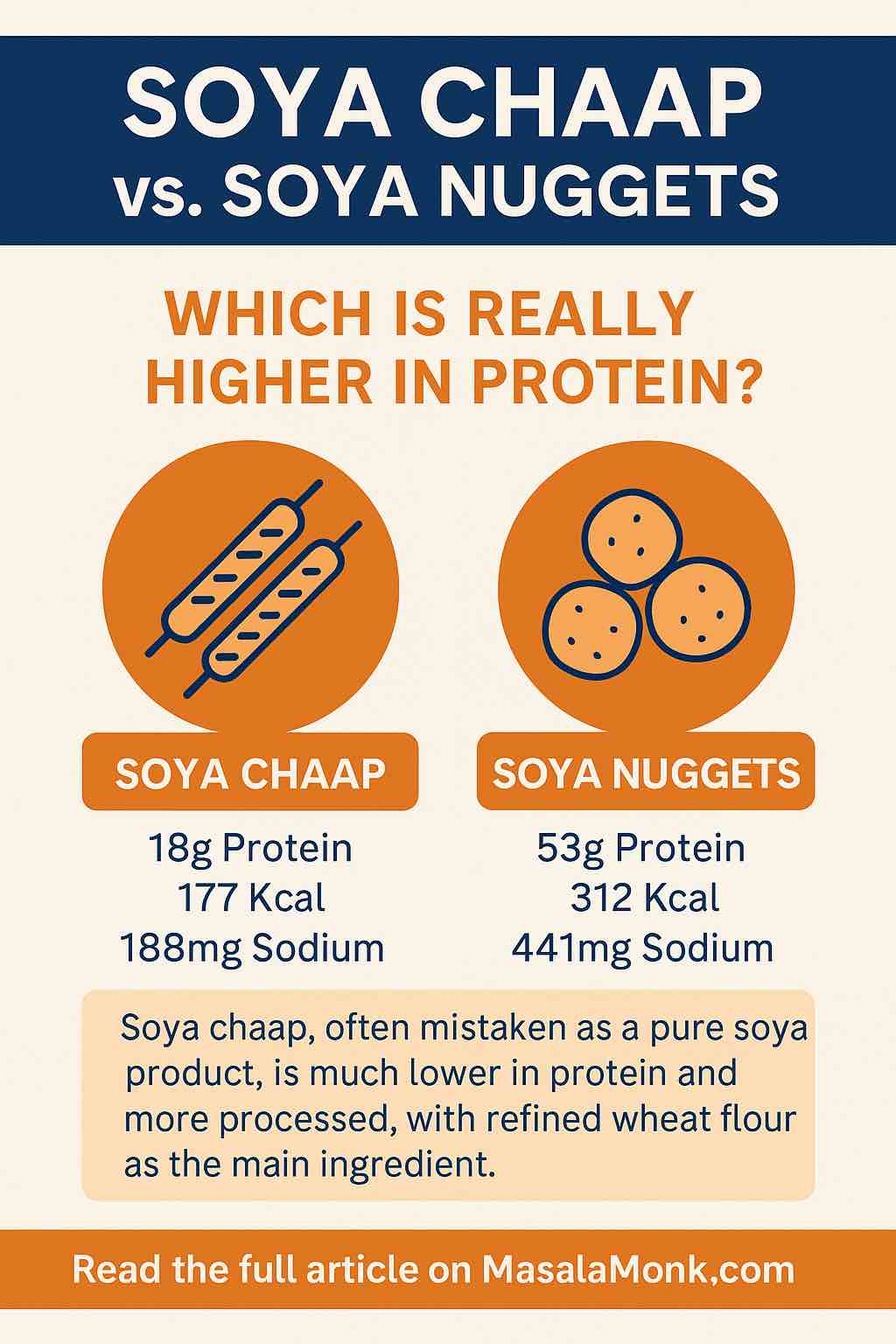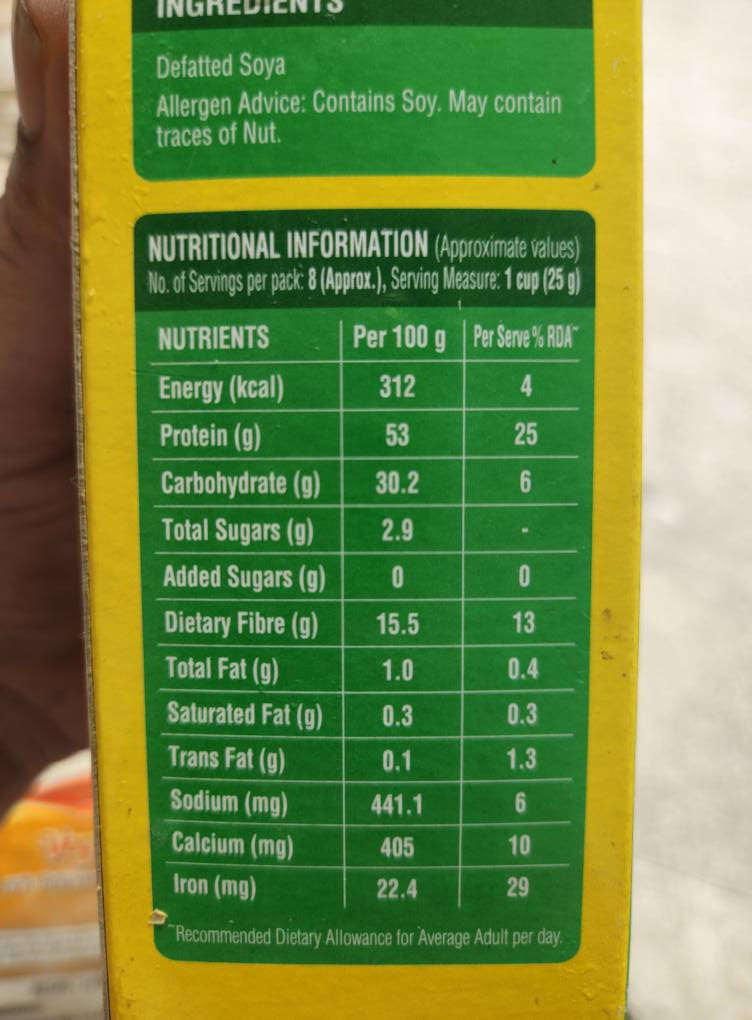
Soya is often hailed as a go-to protein source for vegetarians and vegans in India. Walk through any Indian grocery store or street market, and you’re bound to encounter two popular forms of soy-based foods: Soya Chaap and Soya Nuggets. Both are frequently consumed with the belief that they are rich in protein and nutritious alternatives to meat. However, there’s a significant nutritional divide between these two — especially when you compare branded soya chaap and nuggets, let alone the unpackaged, loose versions. This post dives deep into the micros, macros, and myths around these foods to help you make smarter dietary choices.
What Are Soya Chaap and Soya Nuggets?
Soya Chaap is a processed food typically made from a blend of soya flour, refined wheat flour, wheat gluten, and iodised salt. It’s molded into chunks or sticks, often marinated or cooked like kebabs or curries.
Soya Nuggets, on the other hand, are made from defatted soya flour — essentially the protein-dense residue left after extracting soybean oil. They are much closer to being a pure plant protein source and usually require soaking and cooking before consumption.
Also Read: 10 Vegetarian And High Protein Meal Prep Ideas from Indian Cuisine


🔍 Key Observations Before Calculating Intake
1. Soya Chaap (Branded)
- Main Ingredients: Soya flour + refined wheat flour + gluten + salt.
- Protein per 100g of Soya Chaap: 18g
- High in carbs, sodium, refined ingredients, and has less fiber.
- Not ideal as a pure protein source.
2. Soya Nuggets (Branded)
- Made from defatted soya, very high in protein (53g/100g).
- Excellent fiber (15.5g), low fat (1g), and solid mineral content (Ca, Fe).
- This is a concentrated protein source, closer to a whole-food supplement.
Also Read: The Science of Protein: Maximizing Muscle Growth and Recovery
🧮 What if you want 30g of protein?
Let’s calculate how much you need to eat of each and what macros come with it.
🟧 Soya Chaap: To get 30g protein
- Amount required:
> 3018×100=166.67g\frac{30}{18} \times 100 = 166.67 \text{g}1830×100=166.67g - Macros from 166.7g:
- Calories: 177 × 1.67 = 295 kcal
- Carbs: 21.1 × 1.67 = 35.2g
- • Sugars: 5.92 × 1.67 = ~9.9g
- Fiber: 1.94 × 1.67 = ~3.2g
- Fat: 3.46 × 1.67 = ~5.8g
- Sodium: 188 × 1.67 = ~314mg
- Calcium: 42.68 × 1.67 = ~71.2mg
🟩 Soya Nuggets: To get 30g protein
- Amount required:
> 3053×100=56.6g\frac{30}{53} \times 100 = 56.6 \text{g}5330×100=56.6g - Macros from 56.6g:
- Calories: 312 × 0.566 = ~177 kcal
- Carbs: 30.2 × 0.566 = ~17.1g
- • Sugars: 2.9 × 0.566 = ~1.64g
- Fiber: 15.5 × 0.566 = ~8.78g
- Fat: 1.0 × 0.566 = ~0.57g
- Sodium: 441.1 × 0.566 = ~249.6mg
- Calcium: 405 × 0.566 = ~229.3mg
- Iron: 22.4 × 0.566 = ~12.7mg
Suggested Read: What is Protein?
🔬 Nutrient Load for 30g Protein Comparison
| Nutrient | Soya Chaap (167g) | Soya Nuggets (57g) | ✅ Better |
|---|---|---|---|
| Calories | 295 kcal | 177 kcal | ✅ Nuggets |
| Carbs | 35.2g | 17.1g | ✅ Nuggets |
| Sugars | 9.9g | 1.64g | ✅ Nuggets |
| Fiber | 3.2g | 8.8g | ✅ Nuggets |
| Fat | 5.8g | 0.57g | ✅ Nuggets |
| Sodium | 314mg | 250mg | Close (Chaap slightly better) |
| Calcium | 71.2mg | 229.3mg | ✅ Nuggets |
| Iron | Not known | 12.7mg | ✅ Nuggets |
The Problem with Soya Chaap
While soya chaap may look protein-rich and meaty, the reality is quite different. A closer look at the nutritional label of a branded soya chaap product reveals that it’s far from being a concentrated source of protein.
Soya Chaap Macros per 100g:
- Protein: 18g
- Carbohydrates: 21.1g
- Sugars: 5.92g
- Fat: 3.46g
- Fiber: 1.94g
- Calories: 177 kcal
Here we can see that protein per 100 gm is approx 18g while total calories in 100gm of Soya Chaap is 177 kcal. And these are from branded product with nutritional label, if you are buying from your local vendor, you can never be sure about the Macronutrients in those Soya chaap. What’s more concerning is the presence of refined wheat flour and added gluten, making it a high-carb, moderate-protein food — not ideal if you’re trying to meet high protein goals or manage blood sugar.
Worse, when consumed from loose or unlabelled sources (as is common in many local markets), the soya content may be even lower, with more fillers, preservatives, and negligible quality control.
Why Soya Nuggets Are Superior
Now let’s look at soya nuggets, a much more nutrient-dense and reliable option.
Soya Nuggets per 100g:
- Protein: 53g
- Carbohydrates: 30.2g
- Sugars: 2.9g
- Fat: 1.0g
- Fiber: 15.5g
- Calories: 312 kcal
- Calcium: 405mg
- Iron: 22.4mg
Soya nuggets shine due to their exceptionally high protein content, low fat, and high fiber. They’re also rich in minerals like iron and calcium, essential for vegetarians and vegans who often struggle to meet their daily requirements.
How Much Do You Need to Eat for 30g Protein?
Let’s take a practical look at how much of each food you’d need to eat to get 30g of protein — a decent single meal protein goal for most adults.
To Get 30g Protein:
| Nutrient | Soya Chaap (167g) | Soya Nuggets (57g) |
|---|---|---|
| Calories | 295 kcal | 177 kcal |
| Carbs | 35.2g | 17.1g |
| Sugars | 9.9g | 1.64g |
| Fiber | 3.2g | 8.8g |
| Fat | 5.8g | 0.57g |
| Sodium | 314mg | 250mg |
| Calcium | 71.2mg | 229.3mg |
| Iron | Not listed | 12.7mg |
As evident, Soya Nuggets require almost 1/3rd the quantity to deliver the same protein, with fewer calories, significantly less sugar, more fiber, and way more micronutrients.
For reference do read: Protein in 3 Scrambled Eggs: Nutritional Insights and Benefits.
🔴 Soya Chaap is misleading as a high-protein food:
- You need to eat almost 3x the quantity for the same protein.
- You also ingest 2x calories, 3x sugar, 2x carbs, and much less fiber and micronutrients.
- Especially problematic if consuming unlabeled/street chaap, where wheat filler content may be even higher.
✅ Soya Nuggets are a true protein powerhouse:
- Minimal calories, low fat, high fiber, and rich in iron and calcium.
- Ideal for vegetarians/vegans aiming to meet protein goals cleanly.
Key Takeaways
- Soya Chaap is often overrated as a protein source. It’s more of a processed carb-protein hybrid and can be quite misleading if you’re looking to build muscle or stay lean.
- Soya Nuggets are far superior in terms of protein density, fiber, and micronutrients.
- Unpackaged soya chaap is even more suspect, often made with more fillers and wheat than actual soya.
Practical Advice for Vegetarians and Vegans
- Rely on soya nuggets, tofu, paneer, and lentils for serious protein intake.
- Treat soya chaap as an occasional food — something to enjoy, not depend on.
- Always read nutrition labels and avoid unlabelled chaap from street vendors if you’re aiming for nutritional goals.
- Pair soya nuggets with grains like rice or roti for complete amino acid profiles.
- Monitor sodium intake if you’re consuming soy products frequently.
Final Thoughts
Soya Chaap might be tasty, meaty, and Instagram-worthy, but it’s not the protein-rich superhero it’s often portrayed to be. For anyone serious about nutrition — especially vegetarians and vegans — understanding the difference between true whole-food protein sources and processed imitations is key. Soya nuggets, though humbler in appearance, pack a punch where it matters.
Next time you’re stocking up on protein foods, look past the hype and go for what your body actually needs. Your gut, muscles, and long-term health will thank you.
Suggested Read:
- Embark on a Culinary Adventure: Discover Tempeh in High Protein Vegan Indian Recipes
- The Science of Protein: Maximizing Muscle Growth and Recovery
- Indian Cottage Cheese Jaffles- Vegetarian Protein Rich- Ultimate Comfort Food
- Thai Style Vegan Bowl with Peanut Butter Dressing- 30 grams Protein
✅ Frequently Asked Questions (FAQs)
- Is soya chaap a good source of protein for vegetarians?
Not really. While it does contain protein, branded soya chaap provides only about 18g per 100g and often includes refined wheat flour and gluten. It’s better seen as a protein-carb blend than a pure protein source. - Why are soya nuggets considered better than soya chaap?
Soya nuggets are made from defatted soy flour and offer 53g protein per 100g, along with high fiber and low fat. They’re far more nutrient-dense and efficient for meeting protein goals. - How much soya chaap would I need to eat to get 30g of protein?
You’d need around 167g of soya chaap, which also brings in 295 calories, 35g carbs, and nearly 10g sugar. - How much soya nugget is needed to get 30g protein?
Just about 57g of soya nuggets gives you 30g protein, along with only 177 calories, very low fat, and high fiber. - Is loose or unpackaged soya chaap safe or healthy?
Often not. Unbranded chaap may contain higher wheat filler, preservatives, or poor-quality ingredients. Always prefer branded and labeled options if consuming. - Can I use soya chaap as a daily protein source?
Not ideal. Due to its lower protein and higher carb/sugar content, it’s better consumed occasionally, not as a core daily protein. - Are soya nuggets processed too?
Yes, but far less than chaap. They’re typically just defatted soy flour and retain high protein and fiber, making them a cleaner plant protein. - What’s the fiber difference between the two?
Huge! Soya nuggets offer 15.5g fiber per 100g vs. just 1.94g in soya chaap — important for digestion and satiety. - Are there any drawbacks to eating soya nuggets regularly?
Watch your sodium intake, especially if you’re eating other salty foods. Also, like any food, moderation is key to avoid over-reliance on a single source. - Can I replace meat or eggs with soya nuggets for protein?
Yes, soya nuggets are among the best vegetarian alternatives due to their complete amino acid profile and high protein content.









